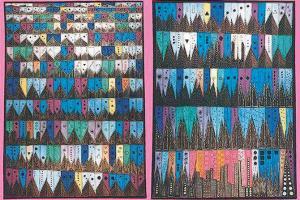A musician and a painter - whose brilliant work was the first symptom of a deadly degenerative brain disease

Anne Adams's painting based on French composer Maurice Ravel's Bolu00c3u0083u00c2u00a9ro
 Around 1979, all the talk in Mumbai was about a sizzling, sexy lady called Bo Derek. The movie was called 10, and it popularised the use of the 10-point scale for rating female sexiness, as in, "She's a perfect 10, man!"
Around 1979, all the talk in Mumbai was about a sizzling, sexy lady called Bo Derek. The movie was called 10, and it popularised the use of the 10-point scale for rating female sexiness, as in, "She's a perfect 10, man!"
Bo Derek was a perfect 10, and in the movie love blossoms between Jenny Hanley (Bo) and an unlikely podgy, middle-aged but cute composer called George Webber (British comedian Dudley Moore). I remember the movie for several reasons, not least of them the havoc Bo Derek played in our steamy adolescent minds.
I remember it for the haunting composition Boléro, by French composer and conductor Maurice Ravel, which was the background score to which Jenny and George first have sex. Hear it here: https://tinyurl.com/me9jjx7
I remember it for the legendary Dudley Moore, whose hilarious routines with Peter Cooke had given me many a laugh. Decades later, in 2015, I remembered it again when my mother lost her life to Progressive Supranuclear Palsy, the same disease Dudley Moore died of in 2002 and the topic of my last column https://tinyurl.com/yafufdsz. Towards the end of their lives, both Moore and my mother could not speak at all, but just stared into nothing, faces frozen in grimaces.
More recently, I learned another odd thing - towards the end of his life Maurice Ravel , composer of Boléro, had complete lost the ability to speak. He had been growing progressively absent-minded since 1932 and got worse after a head blow in an accident that year. Neurologists thought the mishap might have aggravated an existing brain disorder, which they conjectured might be either fronto-temporal dementia, Alzheimer's disease or Creutzfeldt–Jakob disease.
Things get weirder. For the final link in this bizarre story, we meet Anne Adams, a Canadian artist who used to teach chemistry at the University of Toronto before moving to Vancouver with her husband. There she raised four children and re-trained as a cell biologist. When her son was badly injured in a car crash in 1986, doctors said he might not walk again. Anne gave up work to nurse him.
At home full-time now, Anne took up painting, to everyone's surprise. She proved breathtakingly good at it, to everyone's greater surprise. Her gorgeous and fantastical works were built around stunning repetitive themes. She would fixate on strawberries and then it would be strawberry sunrises, strawberry rain and strawberries streaming out of faucets.
Alex recovered fully. However, Anne made a surprising decision not to return to her work, dedicating herself instead to full-time painting. She was successful, making quite a name for herself.
Sometime then, she heard Maurice Ravel's Boléro and became fascinated with it. Fascination grew to obsession and one day she decided to paint the music. On her giant canvas, called Unravelling Boléro, each vertical figure represented a bar of music, its height signifying volume, and colour representing the pitch of Adams' favourite note within that bar.
Like the music, the theme repeats and builds, the colour evolving from orange to a crescendo of pink, like the key change before Boléro's dramatic finalé. It was a precise, intricate work.
A few years later, her friends noticed that Anne was growing increasingly absent-minded and was having difficulty recalling her vocabulary. In time, she completely lost her ability to speak. Exactly as happened to Maurice Ravel, her creative inspirations began to ebb although the urge to paint did not. In her final years, she is described sitting all day in front of a large blank canvas, staring.
Anne Adams and Maurice Ravel are believed to have been suffering from the same neurodegenerative disease, Primary Progressive Aphasia (PPA). The haunting music and vibrant art that emerged from them are now seen as the chilling early symptoms as PPA disabled the rational, verbal parts of their brains.
Around 2000, when Anne was diagnosed with PPA, she was referred to Dr Bruce Miller at the University of California. Miller had shown that some patients with PPA develop a passion for creating art. Anne's MRI scans from 1997 indicate that regions of her front brain involved in processing language had already begun to degenerate.
As the rational, logical, verbal, language-oriented sections of the brain begin to die, a more primitive part of the brain that had been kept in check by the 'rational' brain begins to stir. This 'reptile' brain, as it is called, is driven by basic instincts and repetitive actions - such as those a sparrow uses to build a nest.
Bolero is based on a single repeating melody, swelling in orchestration. Anne's final works consisted of endlessly repeating themes - culminating with her version of Bolero. When I hear that mesmerising melody today, the hair on my neck stands on end.
Here, viewed from there. C Y Gopinath, in Bangkok, throws unique light and shadows on Mumbai, the city that raised him. You can reach him at cygopi@gmail.com Send your feedback to mailbag@mid-day.com
Catch up on all the latest Mumbai news, crime news, current affairs, and also a complete guide on Mumbai from food to things to do and events across the city here. Also download the new mid-day Android and iOS apps to get latest updates
 Subscribe today by clicking the link and stay updated with the latest news!" Click here!
Subscribe today by clicking the link and stay updated with the latest news!" Click here!









